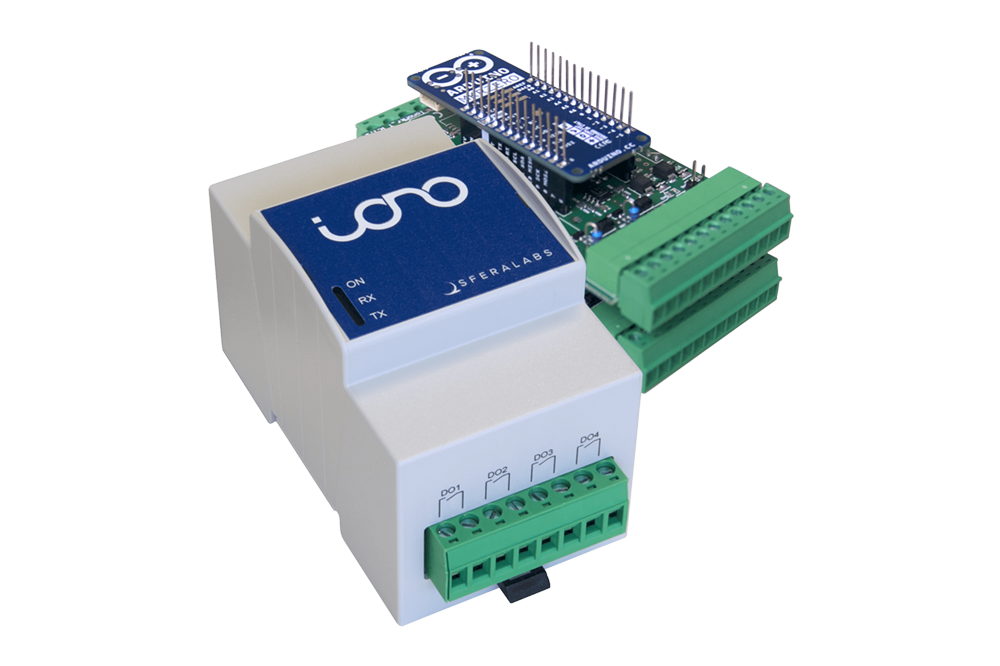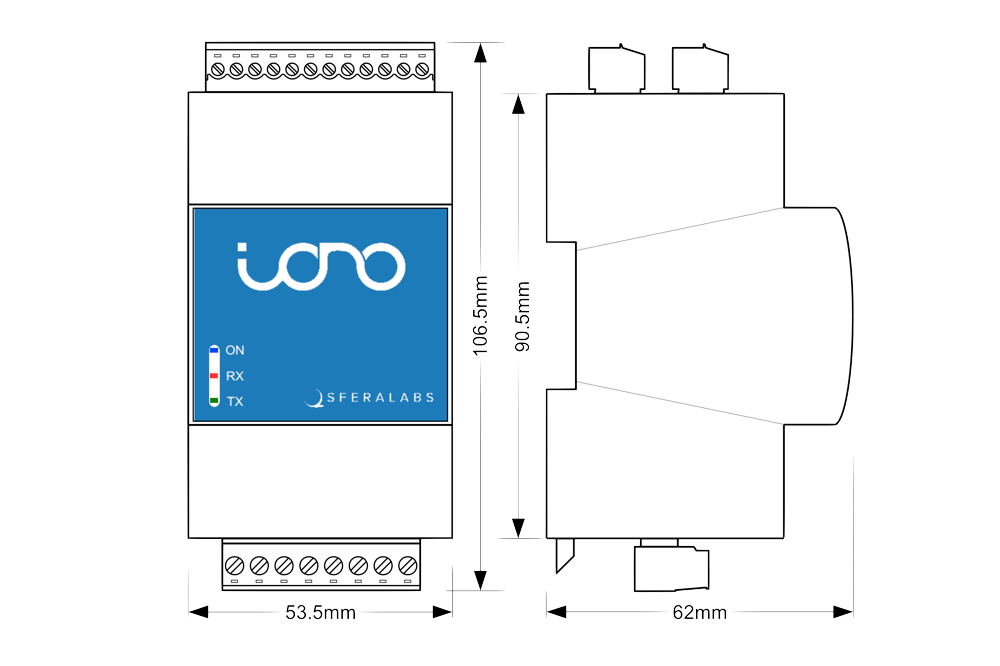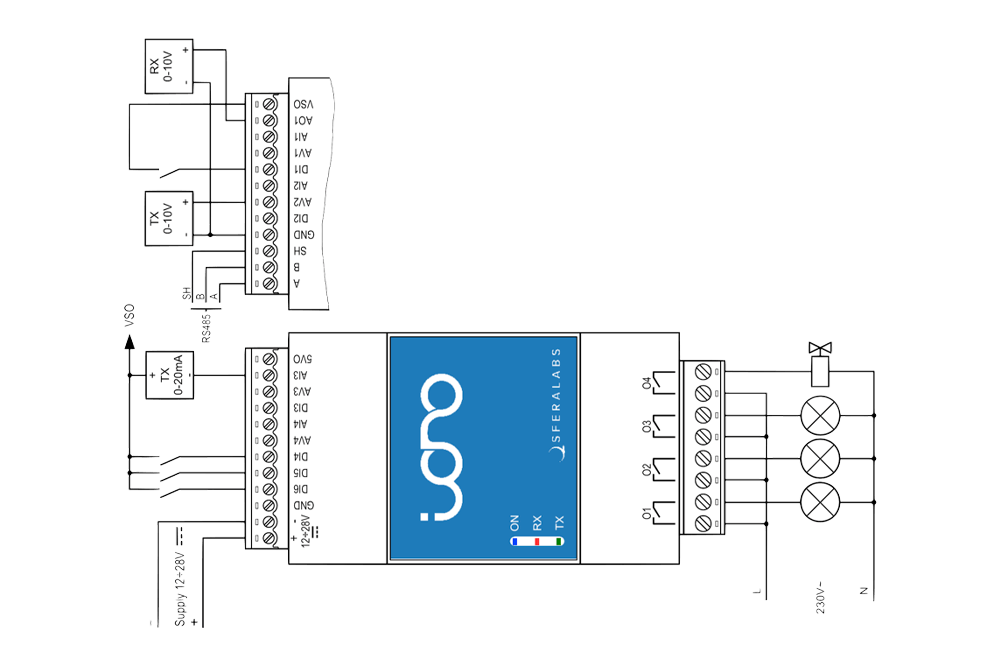Call for Price
Iono MKR is a versatile and compact IO module compatible with all the Arduino MKR boards. All the power of the Arduino platform, combined with WiFi, GSM, NB-IoT, LoRa and SigFox connectivity, in an industrial suit!
Description
An industrial PLC with an Arduino MKR core
The use cases for Iono MKR are simply endless. The power of the SAMD21 Cortex-M0+ 32bit Low Power ARM MCU, featured on the new Arduino MKR boards family, is bound with several industry-standard interfaces, as well as digital and analog input and output lines. Developing on Iono MKR is just the same as programming your Arduino: you use exactly the same IDE, no need for proprietary libraries or drivers and all the available resources from the Arduino community will transparently work. The combination with the many wireless interfaces available on the different Arduino MKR boards makes Iono MKR a perfect fit for IoT solutions, remote data acquisition and remote control.
Iono MKR is packaged in a compact DIN standard case with omega-rail mounts. It can be employed for professional applications where extreme reliability, ruggedness and compliance with technical and safety directives are required.
It is compliant with the 2014/35/UE (Low Voltage) and 2014/30/UE (EMC) CE directives, and the harmonised standards for electromagnetic compatibility (EN61000-6-2:2005), electrical safety (EN60664-1:2007), emission (EN61000-6-4:2007) as well as the RoHS directive for hazardous substances (2011/65/UE).
OS/Software
Iono MKR has 4 analog/digital inputs and 2 digital inputs. These inputs are not directly routed to Arduino’s pins. We use a robust protection circuit with front-end operational amplifiers to safely feed these inputs with industry-standard 0÷10V voltage signals or 0÷20mA current loops. The same inputs can also be used as digital inputs.
The 2 dedicated digital inputs can be used for potential-free contacts, and are also protected with a current-limiting network and capacitive filtering. These inputs can also be reconfigured as bidirectional TTL-level I/O lines, suitable for interfacing with 1-Wire buses or Wiegand devices.
When using the digital inputs, the voltage that can be applied ranges from 0 to 40Vdc. The current flowing in the contacts is rated about 5mA at 24Vdc power supply, to guarantee the cleaning of the contact itself (very low current flowing in a mechanical contact causes oxidation problems and, in addition, reliable operation can be affected by humidity).
Each voltage input features a divider using a resistors network; each current input has a low impedance input converting the input current to a voltage. In both cases, the resulting signal is applied to an operational amplifier with unity gain; the input of each buffer is protected against over and under voltage by a network of resistors and Schottky barrier diodes. The output of the buffer is finally applied to the corresponding analog input of the Arduino board through additional series resistors that add extra protection before the Arduino board.
Power supply
The power supply stage is a heavily protected and filtered circuit, using oversized electrolytic capacitors, diodes and inductors, and a high efficiency, high power voltage regulator, capable of delivering up to 2.0A at the 5V power supply input of the Arduino MKR. This power supply stage can supply power to all current Arduino MKR boards, including the Arduino MRK GSM 1400.
Iono MKR accepts a wide power supply range, from 9 to 28 Vdc, and is able to effectively handle substantial amounts of ripple, noise and supply voltage fluctuations.
Relays
Iono MKR has 4 power relay outputs with normally open contacts, rated for 6A at 250V, which can tolerate peak currents (inrush current) up to 15A.
These relays have a minimum mechanical durability of 5,000,000 operations.
The relays are controlled by 4 output pins of the Arduino board, so they are very easy to control from any software development environment or application.
The relays ensure 5kV insulation between coil and contacts (1.2/50 μs voltage wave), protecting the Iono MKR circuitry and the Arduino board from external surge.
Mechanical construction
Iono MKR server is housed in a DIN standard case with omega-rail mounts. The case is 3-modules wide, equivalent to 53.5mm. The Arduino MKR board is easily stacked on top of the Iono MKR board.
The low voltage terminal blocks, with a 0.15 inch pitch (3.81 mm) are on one side of the case. The high-current terminal block for the relay contact outputs is on the other side and has a larger 0.2 pitch (5.08 mm).
Analog output
Iono MKR has one analog output with a 0÷10V industry-standard range, controlled by the digital to analog converter output of the Arduino MKR board.
The variable voltage level is buffered using a dedicated TSX561 operational amplifier that offers state-of-the-art accuracy and performance and is specifically suited for industrial signal conditioning and harsh automotive applications.
The result is a clean, stable voltage output and improved reliability.
RS-485 serial port
Iono MKR uses the Arduino UART TX/RX pins to implement a standard RS-485 serial port. The RS-485 port is protected from ESD and voltage surges, and supports half-duplex communication up to to 115200 bps.
The RS-485 TX/RX switching is controlled by a digital output pin of the Arduino board.
A 120 Ohm termination resistor between A and B can be enabled installing jumper J3.
Optional features
Iono MKR can be shipped with an optional, factory-installed earthquake sensor module based on the OMRON D7S vibration sensor. It is connected to the Arduino MKR via the I2C bus. The earthquake sensor can be used to disconnect electric loads, activate warning signs, unlock evacuation doors or perform other programmable actions when an earthquake event is detected.
Iono MKR can also be shipped with an optional, factory-installed hardware real time clock with a dedicated long-life non-rechargeable back-up battery. The battery is used to power the RTC chip when the main power is not available.
The RTC module is based on the Microchip MCP79410 real-time clock/calendar chip. It is connected to the Arduino MKR via the I2C bus.
More information
Additional information
| Weight | 0.75 kg |
|---|---|
| Dimensions | 35 × 19 × 8 cm |



